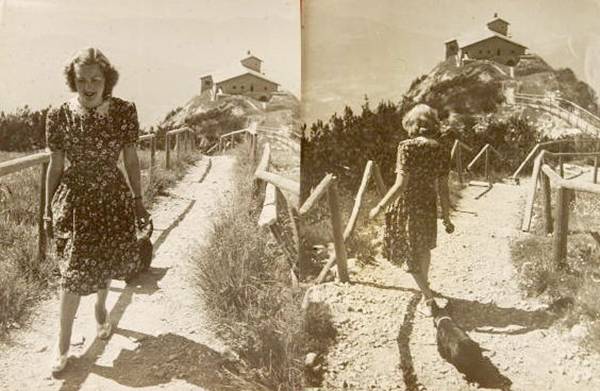Eagles Nest — The Residence of Hitler at the height of 1834 m — The Kehlsteinhaus (in English-speaking countries also known as the Eagle's Nest) is a chalet-style structure erected on a subpeak of the Hoher Göll known as the Kehlstein. It was built as an extension of the Obersalzberg complex erected in the mountains above Berchtesgaden. The Kehlsteinhaus was intended as a 50th birthday present for Adolf Hitler to serve as a retreat, and a place for him to entertain visiting dignitaries. 30 more images after the break...
Construction and usage
The Kehlsteinhaus was commissioned by Martin Bormann, with construction proceeding over a 13-month period. It was completed in the summer of 1938, prior to its formal presentation to Hitler on his 50th birthday on April 20, 1939. It is situated on a ridge at the top of the Kehlstein mountain 1,834 m (6,017 ft), reached by a 6.5 km (4.0 mi) long and 4 m (13 ft) wide road that cost RM 30 million to build (about 150 million euros in 2007, adjusted in line with inflation). It includes five tunnels but only one hairpin turn and climbs 800 m (2,600 ft).
The last 124 m (407 ft)[1] up to the Kehlsteinhaus are reached by an elevator bored straight down through the mountain and linked via a tunnel through the granite below that is 124 m (407 ft) long.[1] The inside of the large elevator car is surfaced with polished brass, Venetian mirrors and green leather (the elevator is still used daily). Construction of the mountain elevator system cost the lives of 12 construction workers. The main reception room is dominated by a fireplace of red Italian marble, presented by Mussolini, which was damaged by Allied soldiers chipping off pieces to take home as souvenirs. Much of the furniture was designed by Paul László.
A significant event held at the Kehlsteinhaus was the wedding reception that followed the marriage of Eva Braun's sister Gretl to Hermann Fegelein on June 3, 1944. The event was filmed and amongst others Martin Bormann can be seen there. The building is often mistakenly referred to as a "tea house", a corruption of its abbreviated name, "D-Haus", short for "Diplomatic Reception Haus". As a result it is frequently confused with the actual tea house at Hitler's Berghof, the Mooslahnerkopf Teehaus, he visited daily after lunch.
Although the site is on the same mountain as the Berghof, Hitler rarely visited the property. It has been suggested he only visited the Kehlsteinhaus around 10 times, and most times for no more than 30 minutes. However he did receive André François-Poncet (the departing French ambassador to Germany) there on October 18, 1938. As a result of the lack of close association with Hitler the property was saved from demolition at the end of the war[citation needed].
Today
Today the building is owned by a charitable trust, and serves as a restaurant. The restaurant features an indoor dining area and an outdoor beer garden. It is a popular tourist attraction, particularly for Britons, Canadians and Americans[citation needed] attracted by the historical significance of the "Eagle's Nest". The house can be reached on foot (two hours of walking) or by bus from Obersalzberg, the road having been closed to private vehicles since 1952.
Informal tours of the Kehlsteinhaus are offered by a local guide to foreigners arriving by local bus at the lower elevator station. The tour is not offered in German, apparently a requirement due to previous trouble with neo-Nazis and post-war Nazi sympathisers. Similarly, the tourist trade towards Kehlsteinhaus has been accused of vindicating Nazism.[citation needed] The lower rooms are not part of the restaurant but can be visited with a guide. They offer views of the building's past through plate-glass windows. Graffiti left by Allied troops is still clearly visible in the surrounding woodwork. A large fireplace in the restaurant itself shows severe damage along its lower edges where soldiers have smashed off small shards of marble as souvenirs. Hitler's small study is now a store room for the cafeteria. A trail leads above the Kehlsteinhaus towards the Mannlgrat ridge reaching from the Kehlstein to the summit of the Hoher Goll. The route, which is served by a Klettersteig, is regarded as the easiest to the top. Wiki Photos
Eva Braun
































0 comments:
Post a Comment